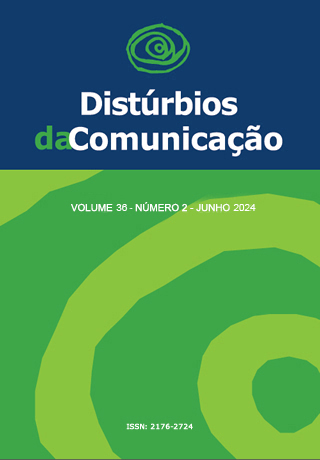Estudantes de fonoaudiologia
autoavaliação da voz, sintomas vocais e diagrama de desvio fonatório
DOI:
https://doi.org/10.23925/2176-2724.2024v36i2e65843Palavras-chave:
Voz, Disfonia, Acústica da fala, Questionário, Qualidade de VidaResumo
Introdução: considera-se importante que fonoaudiólogos apresentem suas vozes como modelo ao realizar uma intervenção fonoaudiológica. Objetivo: conhecer a autoavaliação da voz e sintomas vocais de um grupo de acadêmicos de fonoaudiologia relacionando os achados ao diagrama de desvio fonatório. Método: estudo do tipo analítico, observacional, com 88 estudantes de Fonoaudiologia de uma mesma faculdade, 82 mulheres e seis homens, média de idade de 21,9 anos, sem diagnóstico de disfonia, autorreferidos saudáveis. Foram registrados e comparados dados relativos à autoavaliação da voz e de sintomas vocais, utilizando-se a Escala de Sintomas Vocais. Numa segunda etapa os estudantes foram convidados a realizar uma análise acústica de suas vozes e os que aceitaram (63,6%) procederam com a coleta das amostras de voz, programa VoxMetria® – CTS. Para tratamento dos dados foram utilizados Teste T – student e Matriz de Correlações construída com os resultados do Teste T- student (nível de confiança de 95%, alpha 5%). Resultados: a Escala de Sintomas Vocais revelou 44,31% dos participantes com escores brutos igual ou superior a 16 pontos, indicando risco vocal, com maior comprometimento do domínio físico. Alunos do último ano obtiveram escores mais elevados, com predomínio de secreção e pigarro na garganta. Houve correlação positiva entre fumar (7,95%) e aumento da nota final. A análise acústica revelou 40% das vozes com diagrama de desvio fonatório fora do quadrante de vozes normais, irregularidade da voz, jitter e shimmer alterados. Conclusão: a combinação dos dois instrumentos utilizados para conhecimento de risco de disfonia em estudantes de Fonoaudiologia mostra-se relevante e reforça a importância de programas de prevenção de saúde vocal também em futuros fonoaudiólogos.
Downloads
Referências
Ueda KH, Santos LZ, Oliveira, IB. 25 anos de cuidados com a voz profissional: avaliando ações. Rev. CEFAC. 2008; 10(4): 557-65. http://doi.org/10.1590/S1516-18462008000400016.
Gottliebson RO, Lee L, Weinrich B, Sanders J. Voice Problems of Future Speech-Pathologists. J Voice. 2007; 21(6): 699-704. http://dx.doi.org/10.1016/j.jvoice.2006.07.003.
Van Lierde KM, D’haeseleer E, Wuyts FL, De Ley S, Geldof R, De Vuyst J, et al The objective vocal quality, vocal risk factors, vocal complaints, and corporal pain in Dutch female students training to be speech-language pathologists during the 4 years of study. J Voice. 2010; 24(5): 592-8. http://dx.doi.org/10.1016/j.jvoice.2008.12.011.
Van Lierde KM, D’haeseleer E, Baudonck N, Sofie C, De Bodt M, Behlau M. The impact of vocal warm-up exercises on the objective vocal quality in female students training to be speech-language pathologists. J Voice.2011; 25(3): 115-121. http://dx.doi.org/10.1016/j.jvoice.2009.11.004
Silva RSA, Simões-Zenari M. Impacto de treinamento auditivo na avaliação perceptivo-auditiva da voz realizada por estudantes de Fonoaudiologia. J. Soc. Bras. Fonoaudiol. 2012; 24(1): 19-25.http://dx.doi.org/10.1590/S2179-64912012000100005
Musial PL, Dassie-Leite AP, Zaboroski AP, Casagrande RC. Interferência dos sintomas vocais na atuação profissional de professores. Distúrb Comun. 2011; 23(3): 335-41.
Behlau M, Oliveira G, Santos LMAS, Ricarte A. Validação no Brasil de protocolos de autoavaliação do impacto de uma disfonia. Pró-Fono R. Atual. Cient. 2009, 21(4): 326-32. http://dx.doi.org/10.1590/S0104-56872009000400011.
Moreti F, Zambom F, Oliveira G, Behlau M. Equivalência cultural da versão Brasileira da Voice Symptom Scale: VoiSS. J. Soc. Bras. Fonoaudiol. 2011; 23 (4), pp. 398-400. http://dx.doi.org/10.1590/S2179-64912011000400018.
Moreti F, Zambon F, Oliveira G, Behlau M. Cross-cultural adaptation, validation, and cutoff values of the Brazilian version of the Voice Symptom Scale- VoiSS. J Voice. 2014; 28(4): 458-68. http://doi.org/10.1016/j.jvoice.2013.11.009
Madazio G. Diagrama de Desvio Fonatório Na Clínica Vocal. Tese (Doutorado) – Universidade Federal de São Paulo. Escola Paulista de Medicina, Programa de Pós-graduação em Distúrbios da Comunicação Humana. São Paulo, 2009, 88f.
Fröhlich M, Michaelis D, Strube HW. Acoustic Voice Analysis by Means of the Hoarseness Diagram. J Speech Lang Hear Res. 2000; 43(3): 706-20. https://doi.org/10.1044/jslhr.4303.706
Pifaia LR, Madazio G, Behlau M. Diagrama de desvio fonatório e análise perceptivo-auditiva pré e pós-terapia vocal. CoDAS. 2013; 25(2):140-7.
Oliveira IB, Fernandez ES, Gargantini EP. Disfonias Orgânicas por Neoplasias: análise de diagramas de desvio fonatório Rev. CEFAC. 2015; 17(2): 364-73. https://doi.org/10.1590/1982-021620152714
Joseph BE, Joseph AM, Jacob TM. Vocal Fatigue-Do Young Speech-Language Pathologists Practice What They Preach? J Voice. 2020 Jul; 34(4): 647.e1-647.e5. 10.1016/j.jvoice.2018.11.015
Lima MAG, Barbosa LNF, Sougey EB. Avaliação do Impacto na Qualidade de Vida em Pacientes com Câncer de Laringe. Rev. SBPH. 2011;14(1):18-40.
Kyriakou K, Theodorou E, Petinou K, Phinikettos I. Risk Factors for Voice Disorders in Undergraduate Speech-Language Pathology Students. J Voice. 2022; 16: S0892-1997(21)00411-2. https://doi.org/10.1016/j.jvoice.2021.11.020
Cielo CA, Ribeiro VV, Hoffmann CF. Sintomas vocais de futuros profissionais da voz. Rev CEFAC. 2015;17(1): 34-43. https://doi.org/10.1590/1982-0216201517013.
Silva BGM, Simões-Zenari M, Nemr K. Qual o risco de disfonia em trabalhadores que usam a voz em ambiente universitário? Audiol Commun Res.2021; 26: e2429. https://doi.org/10.1590/2317-6431-2020-2429
Madazio G, Leão S, Behlau M. The Phonatory Deviation Diagram: A Novel Objective Measurement of Vocal Function. Folia Phoniatr Loped. 2011; 63(6): 305-11. https://doi.org/10.1159/000327027.
Downloads
Publicado
Edição
Seção
Licença
Copyright (c) 2024 Iara Bittante de Oliveira, Tamires Dias Rocha

Este trabalho está licenciado sob uma licença Creative Commons Attribution 4.0 International License.









